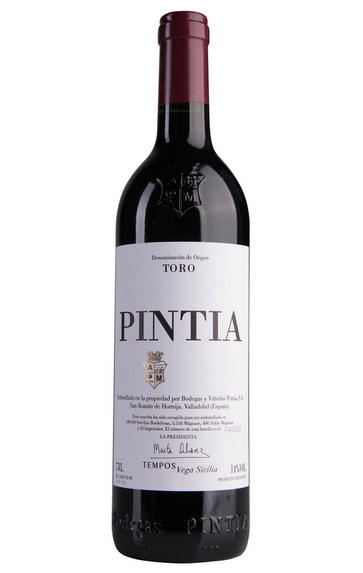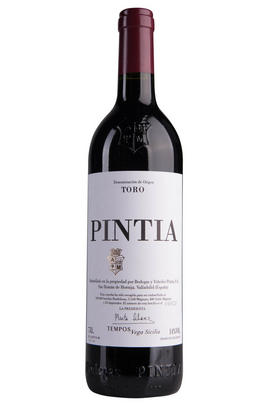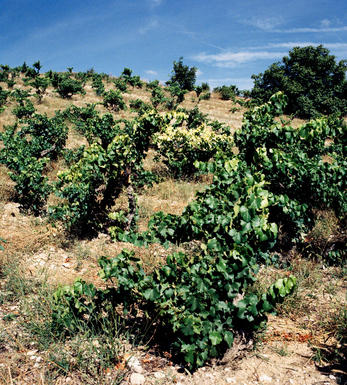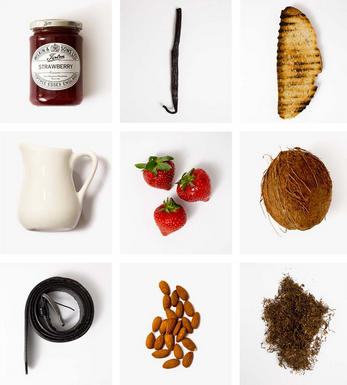
2018 Bodegas Pintia, Toro, Spain

Critics reviews
Very deep purplish crimson. Sweet and chocolatey start but with good savoury grunt underneath. Good energy and rather dry on the finish. Very Spanish! Some freshness rescues it from over-richness.
Drink 2023 - 2032
Jancis Robinson MW, JancisRobinson.com (February 2023)
The 2018 Pintia comes from a cooler and wetter vintage when the grapes were picked between September 20th and October 7th, and it fermented in their new fermentation room where they feel they can be more precise. The wine still has 15% alcohol, with a pH of 3.82 and 4.6 grams of acidity.
It had a shorter élevage this year and matured for 10 months in French and 18% American oak barrels, 81% of them new. The nose is very expressive, with bright cherry fruit, and the wine is fresher than the norm in the region, with integrated alcohol and oak, reflecting a very cool year, floral and perfumed.
The palate is medium-bodied and reveals very fine and elegant tannins. This has to be one of the finest vintages of Pintia. 251,512 bottles, 14,144 half-bottles, 6,543 magnums and some larger formats produced. It was bottled in April 2020.
Drink 2023 - 2029
Luis Gutierrez, Wine Advocate (January 2023)
A smooth, creamy red, medium- to full-bodied, though understated at first. Features flavors of mulled cherry, black plum reduction, cocoa powder and tar-tinged smoke that are seamlessly knit with fine-grained tannins, expanding slowly on a palate carried by balsamico acidity. Long, fragrant finish.
Wine Spectator (2023)
Brooding but fresh nose, with tarry blackberries and fresh blue fruit. Iron, wet stones, violets and a hint of mocha, too. Full-bodied, mineral and broad on the palate with a stony feel, though not heavy at all. A really elegant, nuanced and extremely poised Pintia that you can enjoy now and for the next decade. A really eclectic Pintia showing more elegance and calculation.
Drink or hold
James Suckling, JamesSuckling.com (November 2022)
About this WINE

Bodegas Pintia
Vega Sicilia’s owners, the Álvarez family, bought Bodegas Pintia in 1996, attracted to the galet-strewn terroir in the northern Spanish region of Toro, the rich clay subsoils and the familiar altitude. They decided to produce an alternative expression of Vega Sicilia’s style of Tinto Fino (Tempranillo) from this site.
Toro’s main point of difference to Ribera del Duero is the ambient temperature, which can blaze in the height of summer. The challenge here is to match concentration with elegance, a challenge met by Bodegas Pintia with no shortage of aplomb.

Toro
The wine region of Toro is a predominantly red-wine appellation in Castilla y León in north-western Spain. Toro is situated in the province of Zamora, west of the Rueda and Ribera del Duero wine appellations, and in the Spanish Duero river valley near the Portuguese border.
The Toro appellation covers approximately 5,600 hectares of vineyards at an altitude of 600 to 750 metres above sea level. The region produces red wine across the spectrum from Joven to Gran Reserva, but all grades must be made from at least 75 percent Tinta de Toro (the local name for a clone of the Tempranillo red grape). The best reds tend to contain 100 percent Tinta de Toro and are robust, concentrated and well-structured.
Cabernet Sauvignon is also planted in the region, but not permitted for its DO wines. White wines constitute only a small proportion of Toro production and are made from Malvasía and Verdejo.Toro made its breakthrough when some of the greatest names in the Spanish winemaking scene showed their trust in the region's potential, and moved on to establish their own estates there. These included Vega Sicilia's Álvarez family, Rioja's Marqués de Riscal and Mariano García (the former Vega Sicilia winemaker) with its new Toro winery Mauro-dos.
Jacques and François Lurton of Bordeaux also launched a winery (El Albar) in Toro, where they're making wine both alone and in partnership with renowned oenologist Michel Rolland (at his Campo Elíseo). In Valdefinjas, Rioja's Eguren family of Bodegas Sierra Cantabria has Numanthia-Termes, which makes Termanthia and Numanthia, two of the most well-known wines in the region today.

Tempranillo/Tinto Fino
A high quality red wine grape that is grown all over Spain except in the hot South - it is known as Tinto Fino in Ribera del Duero, Cencibel in La Mancha and Valdepenas and Ull de Llebre in Catalonia. Its spiritual home is in Rioja and Navarra where it constitutes around 70% of most red blends.
Tempranillo-based wines tend to have a spicy, herbal, tobacco-like character accompanied by ripe strawberry and red cherry fruits. It produces fresh, vibrantly fruit driven "jovenes" meant for drinking young. However Tempranillo really comes into its own when oak aged, as with the top Riojas where its flavours seem to harmonise perfectly with both French and American oak, producing rich, powerful and concentrated wines which can be extraordinarily long-lived.
In Ribera del Duero it generally sees less oak - the exception being Vega Sicilia where it is blended with Cabernet Sauvignon and Merlot and then aged for an astonishing 7 years in oak and is unquestionably one of the world`s greatest wines.


Buying options
Add to wishlist
Description
Coming from fairly high altitude, this Spanish red from the Toro region is ethereal, perhaps lighter than you would expect. It is still robust and full, but more delicate, more perfumed with an abundance of incredibly precise blueberry fruit. The oak on this wine is present, but it is well integrated and welcomed. Adding a touch of spice there is a warming character that becomes apparent on the palate. The word smooth comes to mind. This wine is well integrated and very well made.
Drink 2023 - 2030
Luke Dowdy, Account Manager, Berry Bros. & Rudd (January 2023)
wine at a glance
Delivery and quality guarantee